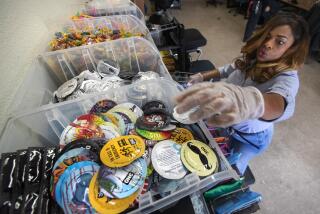Condom Standards Face Revisions
- Share via
A federally backed task force has quietly begun the first major revision in condom standards in five years amid new concerns about the reliability of prophylactics in preventing transmission of the AIDS virus.
The normally routine revision has taken on heightened urgency as a result of the AIDS epidemic and with condoms serving as the centerpiece in “safe sex” campaigns designed to slow the spread of the fatal disease.
Surgeon General C. Everett Koop warned Monday that condom failure rates are “extraordinarily high” among homosexuals--the group at highest risk of contracting AIDS--and that too little attention has been paid to the stresses that anal sex, which many gays practice, puts on prophylactics.
The revision involves an unusual collaboration by the Food and Drug Administration, the condom industry, independent research experts and the American Society for Testing and Materials, a private organization that sets standards for hundreds of products and processes.
In the past, the society’s standards have been controlled by the condom industry and accepted by the federal agency, which says it is not prepared to issue government-developed regulations. The FDA says it still plans to accept the society’s standards, but for the first time they are being developed with broad federal, academic and consumer input.
Two FDA representatives are on the 14-member task force that began meeting 10 days ago in Philadelphia. The group also includes academic researchers, two experts on product testing from the Consumers Union and representatives of condom and medical-device manufacturers.
“I get the feeling there’s a little more urgency and constructive effort this time,” said Charles MacNeill of the FDA’s Center for Devices and Radiological Health.
Russell Culp of Ansell-Americas, one of four U.S.-based condom makers, acknowledged that the entire question of condom effectiveness is receiving a closer look.
“You’ve got a little different situation” with the AIDS threat, said Culp, who is chairman of the standard-revision committee.
The task-force is expected to produce a finished proposal by the end of the year. Proposals under review would:
--Change U.S. testing standards to include a mandatory air inflation test. The International Organization of Standardization already requires a so-called air burst test for condoms in Europe and several other countries, but current U.S. standards call only for a water-leakage test.
--Alter U.S. standards to remove a limit on the thickness of condoms. That could allow the marketing and labeling of condoms with varying degrees of thickness and strength. The change under discussion would set only a minimum thickness--about the level now used in American-made condoms marketed as “ultra-thin.”
--Revise existing tests to measure strength in three sections of a condom instead of just one. A new test also would be added to check the forces required to mechanically tear the condom apart.
FDA officials have repeatedly said they have no plans to impose a government manufacturing standard on condom makers. But a variety of sources say revisions now under consideration by the task force could pressure American manufacturers into taking into account the need to prevent breakage, as well as leakage.
No research Has Been Done
Virtually no research has been done on condom breakage, leakage or overall failure.
“We don’t even know for sure if breakage is far more important than (detecting leaks), but we believe it is,” said Michael Free, vice president of the Program for Appropriate Technology and a member of the task force.
“Manufacturers will tell you that breakage doesn’t amount to a hill of beans,” said Free, whose private organization was started 11 years ago to introduce more effective and standardized birth control methods in Third World counties.
“Yet we know from anecdotes and from our overseas data that breakage is probably considerably higher than zero and considerably higher” than the allowable leakage standard used by the FDA.
Under current standards, the FDA allows a maximum of four out of every 1,000 condoms in a batch to leak water. But a recent testing crackdown spurred by the AIDS crisis found a far higher failure rate in batches of condoms, both foreign and domestic, that were tested at random.
Twenty percent of the batches (meaning as many as one in every 40 to 50 condoms) failed a test designed to detect pinhole leaks that could allow the escape of the AIDS virus.
Free says the pinhole test itself may not be adequate. “Exposure from a pinhole leak is a (gray area),” he said. “How many organisms get through? Can you be infected by just one? But you know that the exposure from breakage is absolute. Shouldn’t we be more concerned about breakage, just on the face of it?”
Research Foundation
His group and one composed of officials from such developing countries as Bangladesh, India, Mexico, Nepal and Botswana are major-testing contractors in an ongoing, federally funded study of condom effectiveness and AIDS organized by UCLA, USC and the Los Angeles-based Mariposa Education and Research Foundation.
“You can say for sure that condoms do give some protection,” Free said. “What it boils down to is: Are they perfect? And of course they’re not. You grasp at remedies according to the risk at hand. The risk at hand is so great that it is not imprudent to grasp at any remedy that seems to have some basis for its effectiveness. The condom has a reasonable basis.”
More to Read
Sign up for Essential California
The most important California stories and recommendations in your inbox every morning.
You may occasionally receive promotional content from the Los Angeles Times.













